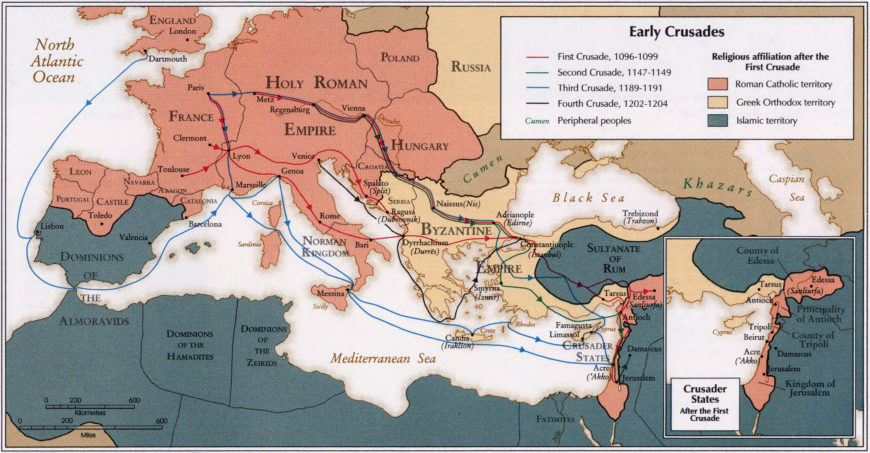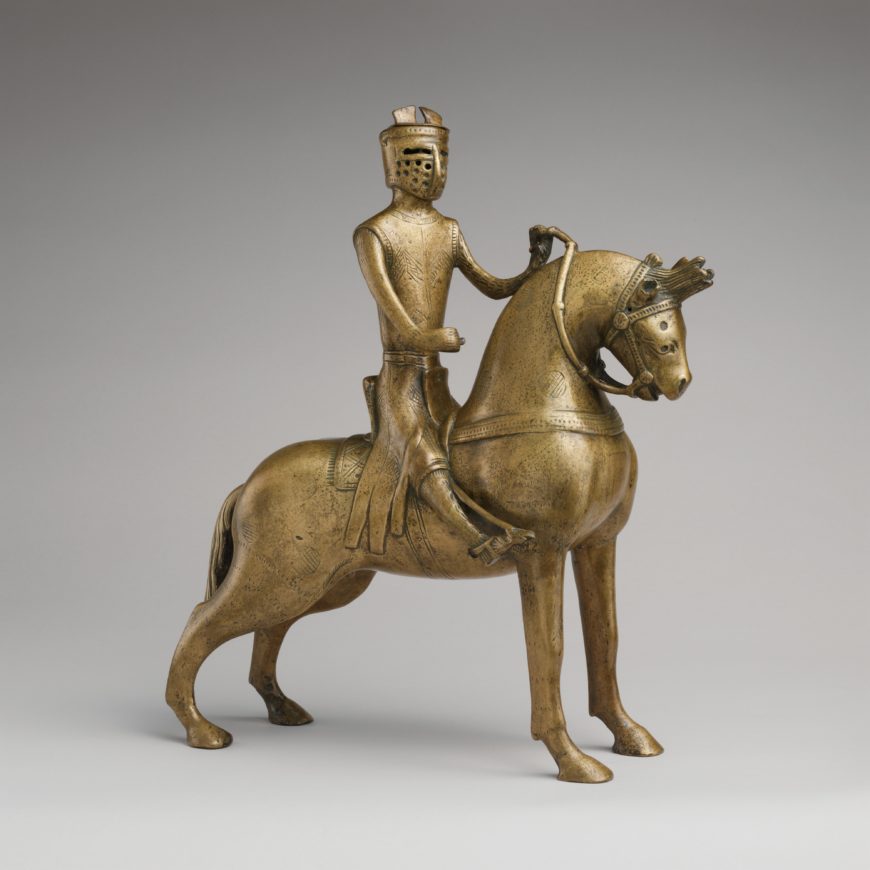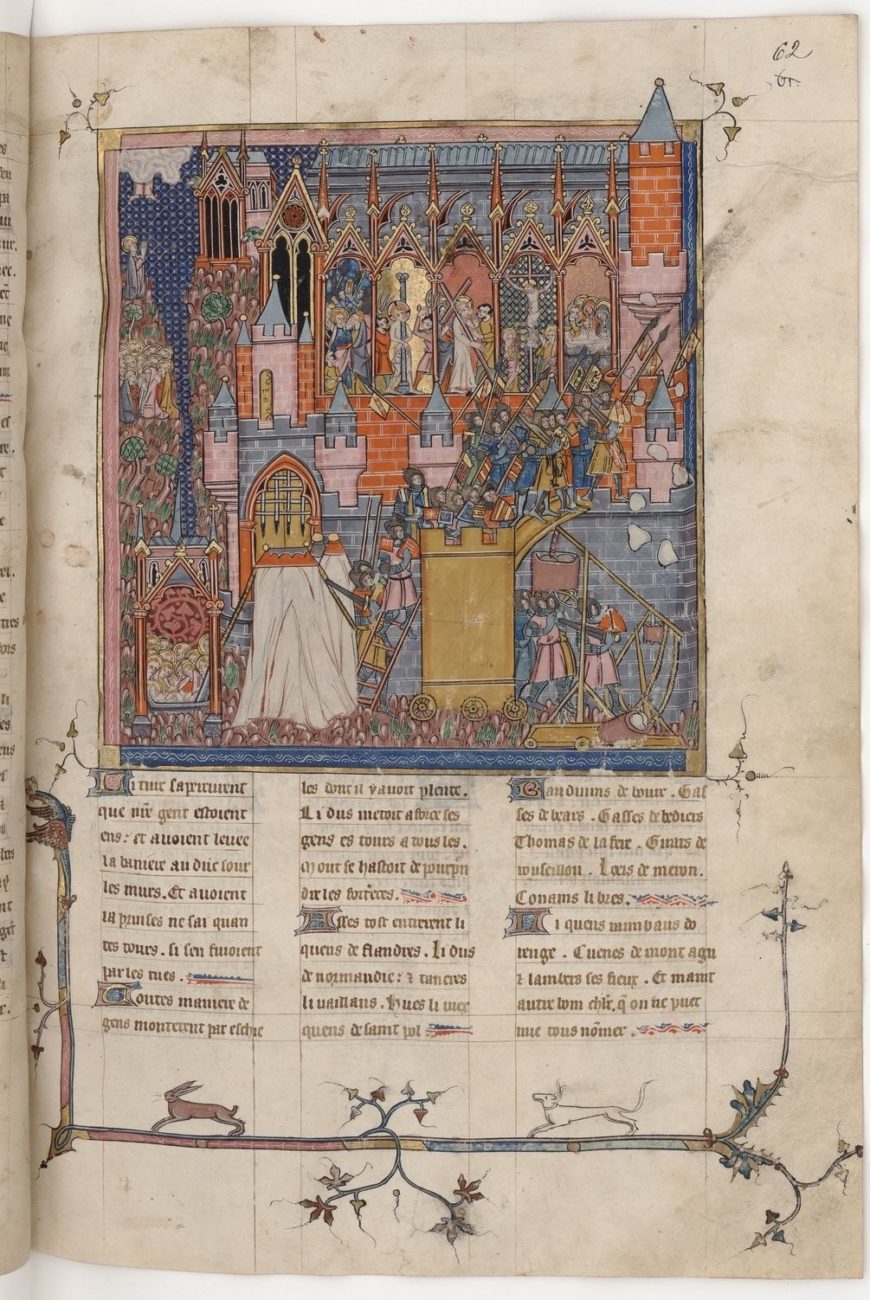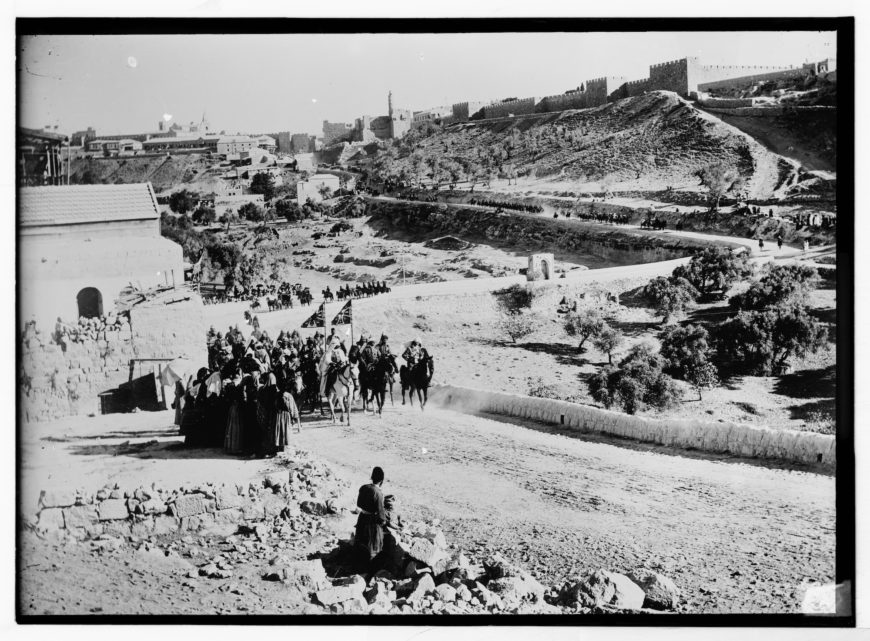What were the crusades?

Crusader, Psalter, with litany, prayers and Easter tables (The “Westminster Psalter”), c. 1200, f. 220 (British Library)
What comes to mind when you think of the crusades? Earnest and alarmingly buff knights (in shining armor, of course) engaged in against-the-odds quests to accomplish godly deeds in an evil world? Red crosses on pure white backgrounds? Orlando Bloom?
This is not surprising. A quick look at our pop culture and politics in the West reveals a continued fascination with the crusades. Compared with popular representations, the historical reality is more complicated and often less heroic.
How do we define the crusades?
Imagine a man-at-arms in the French city of Clermont in 1095. He is listening to Pope Urban II—the only pope he has ever seen in person!—speak passionately about the need to fight in the Holy Land. His lord is persuaded, and gathers his men and resources. The man-at-arms says goodbye to his family, and departs in 1096 on years of painful journeying and military campaigns. He dies of starvation at Antioch, never seeing Jerusalem. His family never knows his fate. This was crusading.
Now imagine Frederick II, Holy Roman Emperor and King of Sicily. Frederick regains Jerusalem from the Muslims without waging war—it helps that he knows Arabic. He is crowned the King of Jerusalem in 1229, but returns to Europe to find the pope waging war on his lands. This, too, was crusading—at least it was for some, though others, like the pope, disagreed.
Finally, imagine an English knight in 1370. He plans to travel to northeastern Europe to fight non-Christians and help Christians there expand their territory. He will go for a season, enjoy feasting and knightly camaraderie, then return home and go back to his regular life, with his reputation enhanced by his trip. You guessed it: this was also crusading.
Crusading took many different forms, and attempting to precisely define crusading has engaged historians in intense debates for more than 150 years.
Scholarly debates
Most of the debates among scholars are concerned with identifying the key characteristics of a crusade. Some, for example, consider only expeditions aimed at Jerusalem or the Holy Land to be crusades. This approach is responsible for the traditional, numbered crusades (i.e., First Crusade, Second Crusade, etc.).
Others downplay the importance of a specific target, and emphasize instead characteristics related to authorization and procedure. These scholars would ask, did a pope authorize the expedition? Did participants take vows and receive certain legal and spiritual privileges? Taking this approach yields a larger number of crusades, spread over a larger geographical area and chronological range. At the same time, some question whether the role of authorities (i.e, the pope) determined a crusade as much as grassroots enthusiasm among ordinary people. These scholars would look, instead, for signs of mass popular support for an expedition. Still others assert that the characteristics of crusading were so diffuse throughout medieval culture that it is impossible and ultimately misleading to attempt to define what was or was not a crusade.
It is also fair to say that many scholars recognize that one can spend too much time seeking a meticulous definition, in essence missing the forest for the trees!
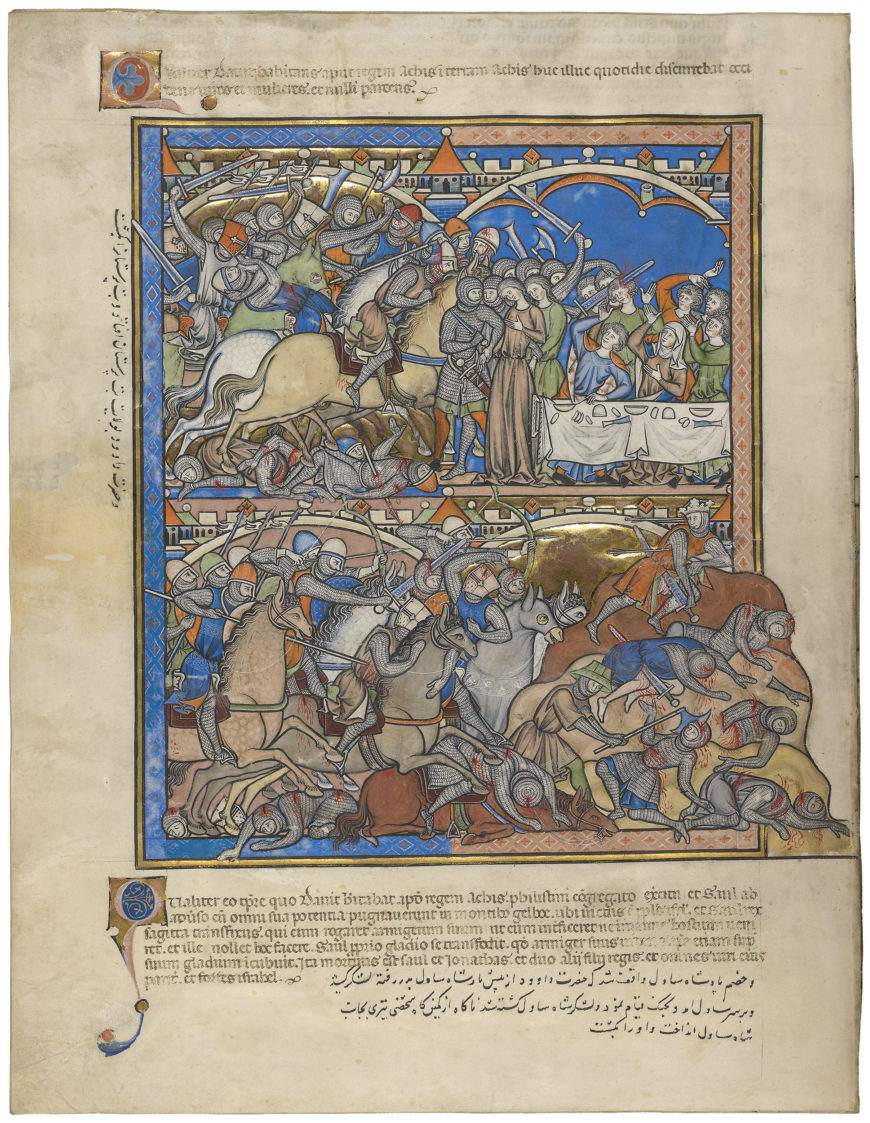
The biblical story of the slaughter of the Amalekites and King Saul’s last stand with the biblical soldiers depicted as French Crusaders, Crusader Bible, fol. 34v, 1244–54, Paris (The Morgan Library and Museum, New York)
Outward signs
If crusading was so nebulous, how did potential participants know what a crusade was? Remember our man-at-arms in Clermont in 1095? He (and his lord) noticed preaching for a new expedition (perhaps emphasizing a papal proclamation, perhaps not), or heard people around him discussing it. Perhaps he also saw others taking public vows and wearing the sign of the cross on their garments. He may have learned of certain legal privileges designed to encourage participation and help protect property and families in the crusader’s absence. Or perhaps he heard of a papal promise of an indulgence (“indulgence” in this context simply means a spiritual benefit of some kind—the precise kind of indulgence offered for crusading changed over time).
Finally, our man-at-arms was interested in crusading, but for others, someone with authority over them (or someone they loved), may simply have told them it was happening or that they were going. Much like today, some people may have simply paid attention to their taxes; at times, especially in the later Middle Ages, both the Church and secular authorities levied funds for new expeditions. Any or all of these factors may have caught people’s attention, especially if they came from a family or region with a tradition of crusade participation. Meanwhile, for those who were the targets of crusader violence, presumably the only sign needed was the sight of an approaching army bedecked with crosses.
Different points of view
While it’s valuable to seek to understand the crusades from the perspective of participants, it’s equally important to seek out different points of view. Internal criticism of the crusading movement was more limited than many today might expect. What criticisms existed were usually leveled at specific expeditions or participants, rather than at the idea of crusading in general or the underlying attitudes towards religion and violence that made crusading possible.
Muslim voices, whether in the Iberian Peninsula (what is now Spain and Portugal), the Levant (the eastern Mediterranean), or further afield, described the crusades in different ways—often as simple territorial expansion, religious warfare, or a combination of the two. Descriptions of the “Franks” themselves (as the crusaders were called) ranged from respect to ridicule to hostility.
Records from Jewish communities around the Mediterranean sometimes described an undiscriminating ferocity and zealous fervor held by many crusaders, a theme also underlined by Christians within Europe who did not conform to Church teachings, and thus were called “heretics.” Some accounts of the crusades from the Byzantine Empire (a medieval state based on the remains of the classical Roman Empire) emphasized the purported “barbarity” and relative naivete of the crusaders.
Cite this page as: Dr. Susanna Throop, “What were the crusades?,” in Smarthistory, August 8, 2015, accessed May 15, 2024, https://smarthistory.org/what-were-the-crusades-1-of-4/.
How was crusading justified?
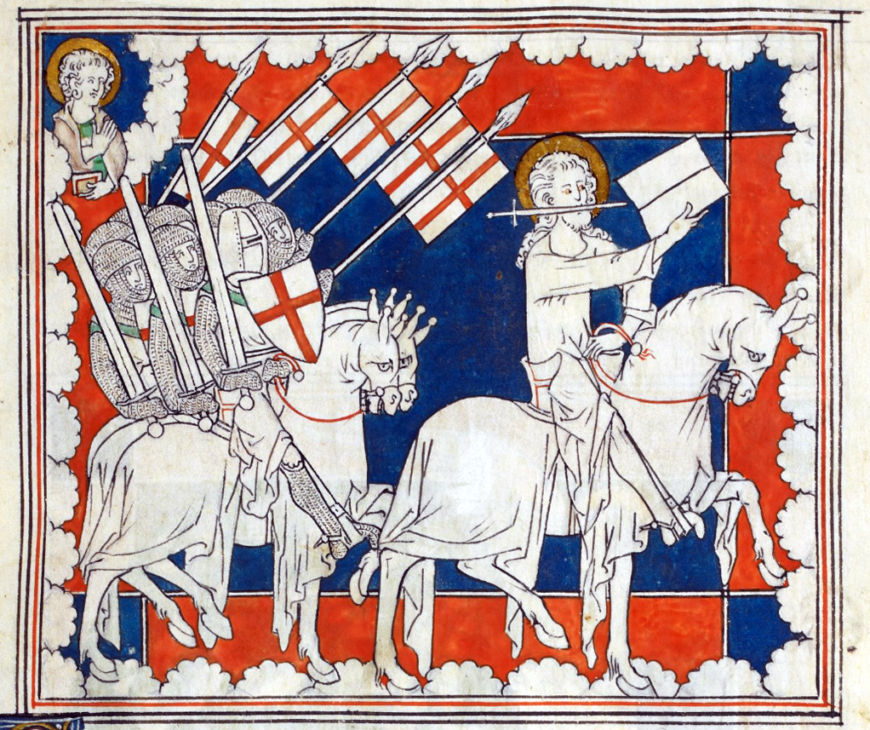
Christ leading crusaders into battle, detail from an Apocalypse, with commentary (The “Queen Mary Apocalypse”), early 14th century, f. 37 (British Library)
Just warfare
Crusades were wars—that is firm ground. More specifically, crusading was represented as just warfare, according to the idea of just war established by St. Augustine of Hippo.
Augustine wrote that warfare was sometimes a necessary and lesser evil in certain conditions. Specifically, a war could be just if there was:
a) just cause,
b) legitimate authority, and
c) right intention.
A just cause was a previous injury or act of aggression. As a result, crusading was described as defensive.
A legitimate authority was just that: an authority who held the power—granted by God, from Augustine’s perspective—to invoke war. Crusading, it was argued, was authorized by popes and legitimate secular leaders.
Participants had the right intention if they believed war was completely unavoidable and sought only to use minimal force to check aggression against them. In theological terms, participants were supposed to be motivated by Christian love, (i.e. charity), rather than by anger, hatred, or fear. Crusade supporters stressed that participants were driven by the desire to help liberate purportedly oppressed Christians and save them from purported atrocities and slavery, and the desire to do the same for the personified Church or even Christ himself, both supposedly injured by the enemies of the crusaders.
But participating in a just war could still be sinful. For example, Duke William I of Normandy’s invasion of England was considered just, but Norman participants had to do penance afterwards. So saying that crusading was a just war wasn’t enough. Many writers communicated that crusading was holy warfare, meaning that it was a just war that was not only authorized but also realized by God himself. In theological terms, then, God was the one taking action; God was the one waging war. Crusaders were divine tools, rather than moral agents in their own right. It was this belief that led one monk, Guibert of Nogent, to title his account of the First Crusade “The Deeds of God done through the Franks” (he was not-so-subtly revising an earlier, and in his opinion theologically crude account, titled “The Deeds of the Franks”). Of course, if a crusade was a holy war, then the enemies of crusading were enemies of God and the whole Christian faith, not just enemies of particular Christians—and that was precisely how Muslims and other crusader targets were depicted in many pro-crusade accounts.
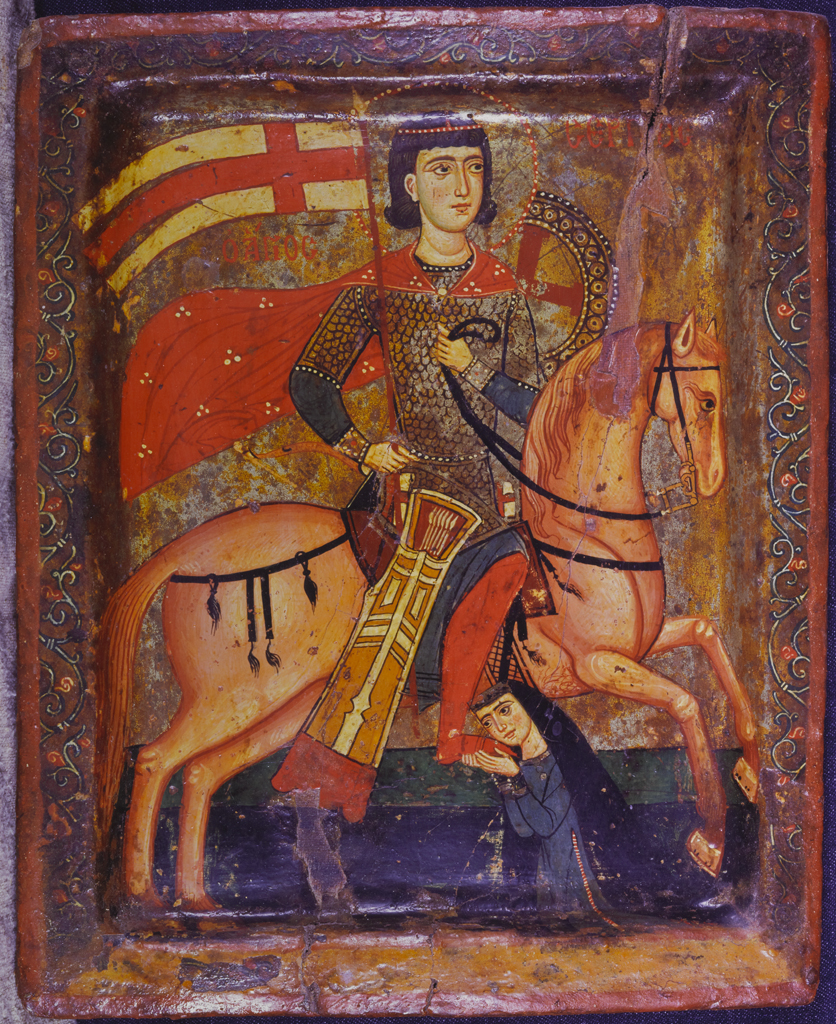
Crusader icon with St. Sergius carrying a crusader standard featuring a red cross on a white ground, with a female door, 13th century, from the Monastery of Saint Catherine at Mount Sinai, Egypt (photo: published through the Courtesy of the Michigan-Princeton-Alexandria Expeditions to the Monastery of St. Catherine on Mount Sinai)
Penitential warfare
Finally, crusading was also represented as penitential warfare. This means that crusading was believed to be an act of penance—a way to make amends to God for sins one had committed, so that an individual could achieve salvation. It means that crusading was not simply seen as a necessary evil—it was seen as a positive spiritual good for those who participated. Participants were not merely excused for their involvement; they actively acquired spiritual merit. In the simplest terms, crusading was presented as a good deed, even though it involved killing people.
To make sense of this, we need to recognize that violence was often perceived to be much more morally neutral in medieval Europe than it is today. Violence acquired its moral value from intentions and context, like who was performing the violence and to whom it was done (this should remind you of Augustine’s just war theory: cause, authority, and intentions). Thus, the same action—let’s say, hitting someone in the face—could be immoral and unchristian in one context, and moral and Christian in another.
Given the penitential element in crusading and the number of expeditions that involved long journeys to holy places, it is not surprising that crusading was often described as a pilgrimage, a journey to a holy location like a shrine, a church, or even an entire city, like Jerusalem. Those who went on pilgrimage frequently sought spiritual advantages, like forgiveness of sins or a closer relationship with God or a saint; they also sometimes hoped for more earthly advantages, like healing. Pilgrimage was a sacred act for medieval Christians, and was itself often an act of penance (sometimes voluntary, sometimes assigned by a priest in confession). Crusading borrowed some of the language, rituals, and symbols of pilgrimage, and shared its penitential nature.
Changing definitions
It’s important to emphasize again that people didn’t write a theory of crusading in advance. There wasn’t even a specific word for “crusade” until more than 100 years after the First Crusade. In addition, the nature of crusading seems to have operated differently and meant different things depending on time, place, and participants.
Cite this page as: Dr. Susanna Throop, “How was crusading justified?,” in Smarthistory, August 8, 2015, accessed May 15, 2024, https://smarthistory.org/how-was-crusading-justified-2-of-4/.
The when, where and who (of crusading)
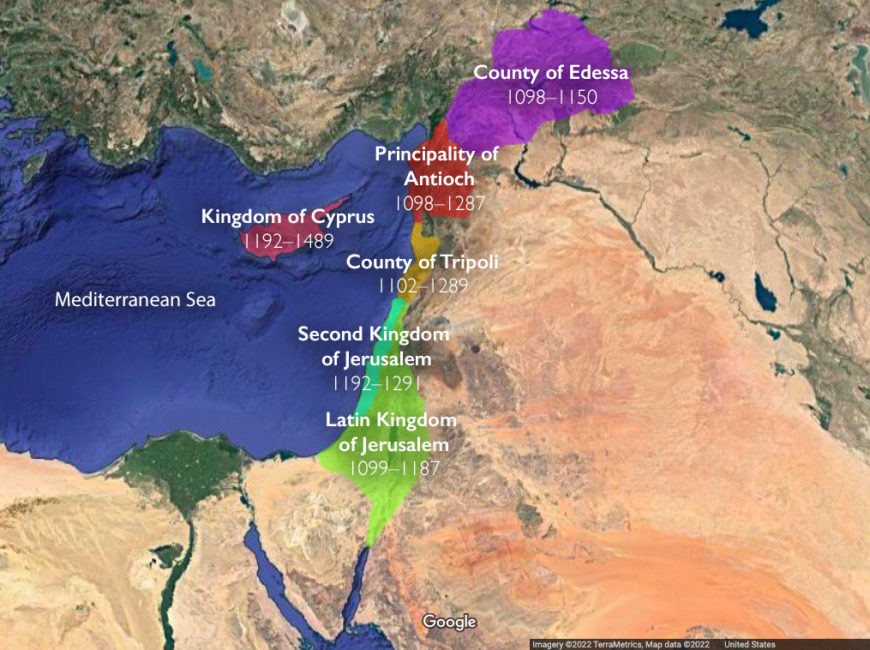
Map of Crusader States (underlying map © Google)
Setting a timeline
In some ways, setting a beginning date for the crusading movement is relatively easy. The First Crusade was preached by Pope Urban II in 1095. Several different expeditions responded to this appeal, but the general dates for the First Crusade are 1096–99, when the city of Jerusalem was conquered. Keep in mind though that crusading didn’t emerge from a vacuum, and many of the elements of crusading were circulating before 1095.
However, finding an end date for the crusades is quite difficult indeed. Scholars used to stress that the heyday of crusading was before 1300. But we now know that crusading continued to flourish—as an ideal even when not in practice—for many centuries after that. Some place the end date at 1571, when the rising Ottoman Empire defeated the Kingdom of Cyprus at the city of Famagusta. Others place it in the late nineteenth century, when the last attempt at a military order (i.e., a Catholic armed religious order, like the medieval Knights Templar) ended. The argument can be made—and is in fact made by some groups around the world—that the crusades never ended at all.
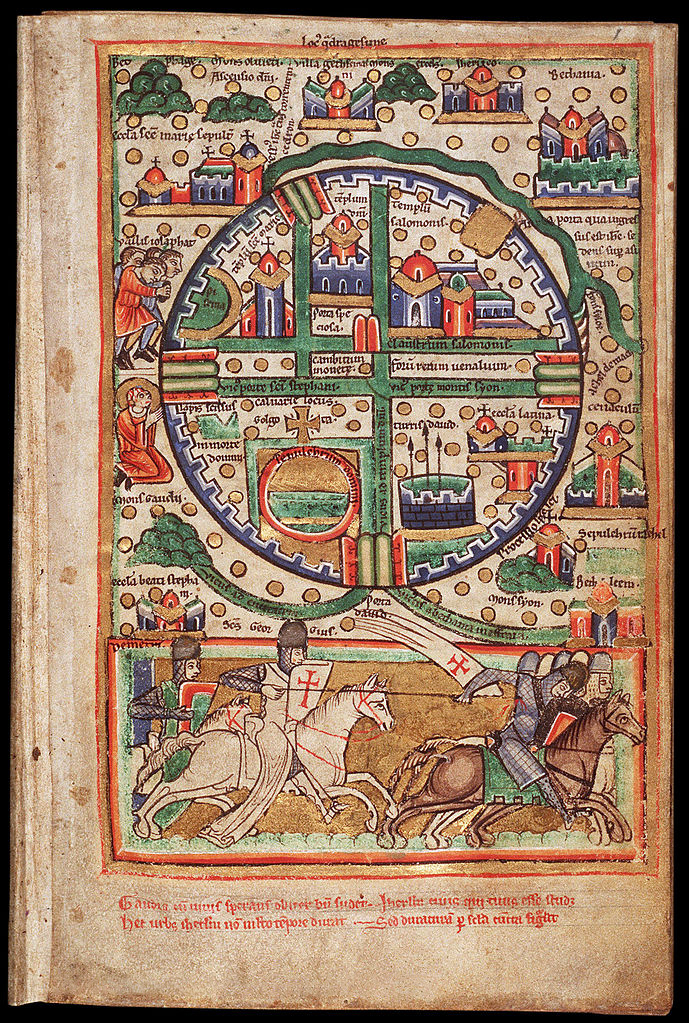
Map of Crusader Jerusalem, Deeds of the Franks who attacked Jerusalem (Gesta Francorum Hierusalem expugnatium), Saint-Bertin, France, late 12th century, with scene of two military saints, Sts. Demetrios and George, vanquishing an unidentified enemy (Koninklijke Bibliotheek, The Hague)
Theaters and targets
The First Crusade was launched at the Levant (the region at the end of the eastern Mediterranean) with the stated purpose of rescuing Christians and bringing the Christian holy places—specifically Jerusalem—back into (European) Christian hands.
Of all the crusades to the region, the First was the most successful (from the perspective of European participants), and led to the creation of small polities in the Levant, known as the crusader states. European nobles first governed these small states, which were inhabited by some settlers from western Europe as well as native Christians, Jews, and Muslims.
By the time the Second Crusade rolled around (1146–49) crusading had already expanded dramatically. The Second Crusade took place on three fronts: against Muslims in the Levant, against pagans in northern Europe, and against Muslims on the Iberian peninsula (modern day Spain and Portugal). This does not mean that all three fronts were coordinated, as in a modern war. Rather, it means that contemporaries believed that the wars on all three fronts together constituted a larger endeavor.
We should also remember that the Levant and Iberia contained any number of local Christians, Jews, and other religious groups, and they were not always exempted from crusader violence, even though it was held to be wrong to persecute or kill fellow Christians and Jews.
After the Second Crusade, crusading continued to expand and evolve. Muslims (or areas under Muslim governance) continued to be targets, especially when they threatened or reconquered portions of the crusader states, but other targets included Christian “heretics” (for example, in southern France), the Christian Byzantine Empire, and political opponents of the papacy within Europe.
Crusading also developed local traditions. In northern Europe, crusading became a festive seasonal rite of passage for western European knights, complete with honorary feasts and prizes. In other places, crusading interacted with pre-existing factors, for example in Iberia, where both ideas of crusading and of the “Reconquest” were influential. In still other places, again in northern Europe but also Malta, the military orders—armed religious orders (most famously the Knights Templar)—set up independent, or virtually independent states dedicated to perpetual crusading.
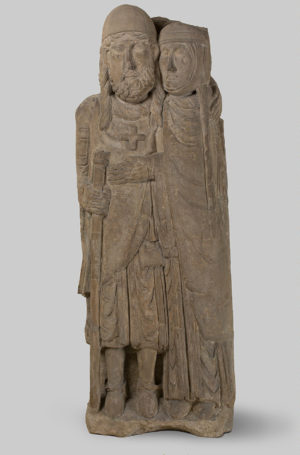
A departing or returning crusader being embraced by his wife, from the Belval Priory, Lorraine, late 12th century (Musée Lorrain, Nancy)
Participants
Who went on crusade? From the beginning, popes and other leaders sought to encourage only professional men of war, whether kings, lords, knights, or simple men-at-arms, to go on crusade. And from the beginning, individuals of almost every other social class, age, and gender ignored this and wanted to go, too. The only people explicitly forbidden from going on crusade were those who had taken religious vows (like priests and monks), and even then, many tried to find a way to go—and, indeed, many went.
This doesn’t mean that everyone in Europe was pulled inexorably into crusading like water down a drain. Crusading was expensive, and it was very risky. To go on crusade meant leaving your loved ones and your property (if you had any) vulnerable for at least several years and possibly forever. Going on crusade was not an “easy out” for younger sons (as used to be thought) nor was it a reliable treasure-hunting expedition; it impoverished many more people than it profited. Nonetheless, because of the spiritual and social rewards on offer for crusading, crusade leaders were never able to fully stop people of both genders and all classes from accompanying armed parties on crusade, and it is fair to say that many expeditions, especially those to the Levant, included a wide range of age, social classes, and military experience.
Cite this page as: Dr. Susanna Throop, “The when, where and who (of crusading),” in Smarthistory, August 8, 2015, accessed May 15, 2024, https://smarthistory.org/the-when-where-and-who-of-crusading-3-of-4/.
The impact of the crusades
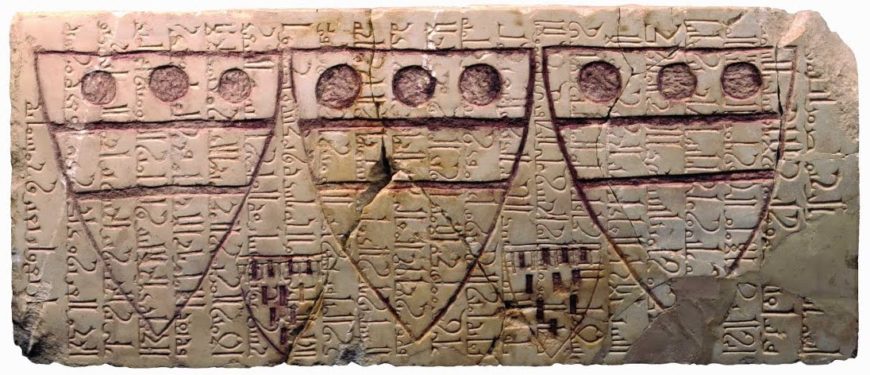
Wall plaque, Ascalon, mid-twelfth to mid-thirteenth century. The Arabic inscription commemorates the wall built as defense against crusaders. The arms of Sir Hugh Wake (Lincoln, England) were later carved over that, confirming the 1241 crusader reconquest of the city (Israel Museum, Jerusalem; photo: Google Arts & Culture)
It is hard to summarize the impact of a movement that spanned centuries and continents, crossed social lines, and affected all levels of culture. However, there are a few central effects that can be highlighted.
Military orders
First, the earliest military orders originated in Jerusalem in the wake of the First Crusade. A miltary order is a religious order in which members take traditional monastic vows—communal poverty, chastity, and obedience—but also commit to violence on behalf of the Christian faith. Well-known examples include the Knights Templar (officially endorsed in 1129), the Knights Hospitaller (confirmed by papal bull in 1113), and the Teutonic Knights (originated in the late twelfth century).
The military orders represented a major theological and military development, and went on to play central roles in the formation of key political units that still exist today as nation-states.
Territorial expansion
Second, crusading played a major role in European territorial expansion. The First Crusade resulted in the formation of the crusader states in the Levant (the eastern Mediterranean), which were initially governed, and in small part populated, by settlers from Europe.
Crusading in northern and eastern Europe led to the expansion of kingdoms like Denmark and Sweden, as well as the creation of brand-new political units, for example in Prussia. As areas around the Baltic Sea were taken by the crusaders, traders and settlers—mostly German—moved in and profited economically.
In the Mediterranean Sea, crusading led to the conquest and colonization of many islands, which arguably helped ensure Christian control of Mediterranean trade routes (at least for as long as the islands were held). Crusading also played a role in the conquest of the Iberian peninsula (now Spain and Portugal). This was finally completed in 1492, when the Spanish monarchs Ferdinand II and Isabella I conquered the last Muslim community on the peninsula—the city of Granada. They expelled Jews from the country in the same year. And of course, they also authorized and supported the expeditions of Christopher Columbus, who—like many European explorers of his day—believed that the expansion of the Christian faith was one of his duties.

Tympanum above the south door of St. George’s Church, Fordington, Dorset, early 12th century (photo: Michael Day, CC BY-NC 2.0)
Impact in Europe (religious and secular)
Third, the crusading movement impacted internal European development in a few important ways. The movement helped both to militarize the medieval western Church and to sustain criticism of that militarization. It arguably helped solidify the pope’s control over the Church and made certain financial innovations central to Church operations. And it both reflected and influenced devotional trends. For example, while there was some dedication to St. George from the early Middle Ages, the intensity of that devotion soared in Europe after he reportedly intervened miraculously at the Battle of Antioch in 1098, during the First Crusade.
Secular political theories were influenced by crusading, especially in France and the Iberian peninsula, and government institutions evolved in part to meet the logistical needs of crusading. Credit infrastructures within Europe rose to meet similar needs, and some locales—Venice, in particular—benefitted significantly in economic terms.
It goes without saying that the crusades also had a highly negative effect on interfaith relations.
Impact world-wide
Fourth, the crusading movement has left an imprint on the world as a whole. For example, many of the national flags of Europe incorporate a cross. In addition, many images of crusaders in our popular culture are indebted to the nineteenth century. Some in that century, like the novelist Sir Walter Scott, portrayed crusaders as brave and glamorous yet backward and unenlightened; simultaneously, they depicted Muslims as heroic, intelligent, and liberal. Others more wholeheartedly romanticized crusading.
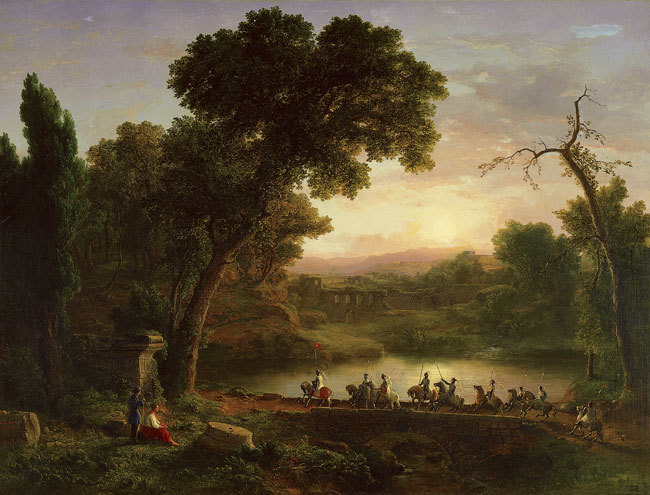
George Inness, Classical Landscape (March of the Crusaders), 1850, oil on canvas (Fruitlands Museum, Harvard, Massachusetts)
These trends in nineteenth-century European culture impacted the Islamic world. Sometimes this influence was quite direct. In 1898 German Emperor Wilhelm II visited the grave of Saladin (Ṣalāḥ ad-Dīn Yūsuf ibn Ayyūb, a Muslim leader who led the recapture of Jerusalem in 1187) and was appalled at its state of disrepair. He paid to have it rebuilt, thus helping encourage modern Islamic appreciation of Saladin.
Sometimes the European influence was more diffuse. Modern crusading histories in the Islamic world began to be written in the 1890s, when the Ottoman Empire was in crisis. After the Ottomans, some Arab Nationalists interpreted nineteenth-century imperialism as crusading, and thus linked their efforts to end imperial rule with the efforts of Muslims to resist crusading in previous centuries.
It would be reassuring to believe that nobody in the West has provided grounds for such beliefs, but it would not be true. Sadly, the effects of the crusading movement—at least, as it is now remembered and reimagined—seem to be still unfolding.
Cite this page as: Dr. Susanna Throop, “The impact of the crusades,” in Smarthistory, August 8, 2015, accessed May 15, 2024, https://smarthistory.org/the-impact-of-the-crusades-4-of-4/.

